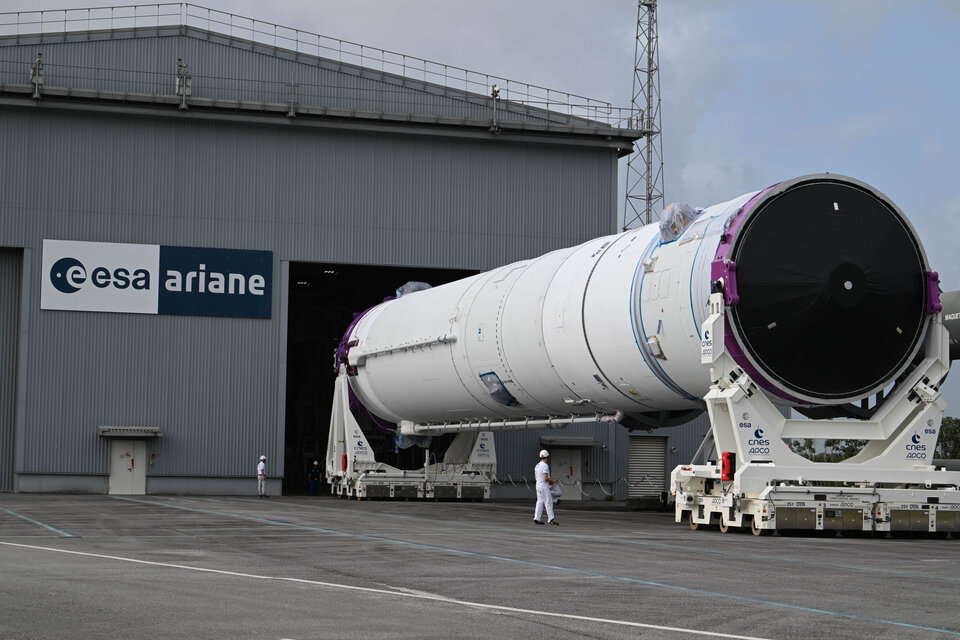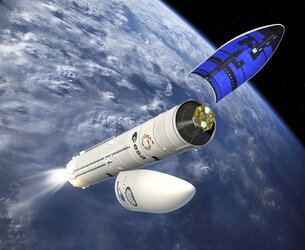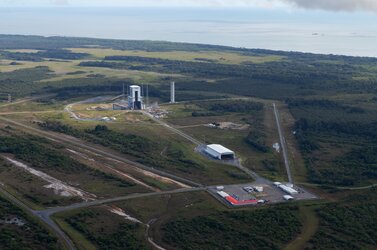Ariane 6: the launch zone
While the Ariane 6 rocket itself might take much of the focus, the launch pad and infrastructure are marvels of human engineering in itself.

Built and operated by France’s space agency CNES, the launch complex at the Ariane 6 launch zone – called ELA4 – was built from the ground up at Europe’s Spaceport in French Guiana. Building on the success and lessons learnt from the previous launch zones, the new infrastructure allows for quick processing and a launch cadence of one Ariane 6 a month and has been designed to lessen the site's carbon footprint and preserve local natural resources.
The site for the launch zone was chosen for its deep rocky subsoil capable of supporting the heaviest 900 tonne variant of Ariane 6 and its liftoff and the mobile gantry that surrounds Ariane 6 for final assembly. Building the launch pad started in 2015 and was completed and qualified for use in 2023.
A building that moves

The mobile gantry is a huge 90-metre-high building on rails that weighs more than the Eiffel tower. Hours before launch it rolls 120 m away from the launch pad in just 20 minutes, leaving Ariane 6 a clear ascent to the skies. The building is oriented to take the steady winds into account that blow in the region, allowing for efficient cooling .
The launch tower provides ventilation for the payloads at the top of the rocket, electricity and liquid propellant that is loaded into Ariane 6 at temperatures below –180°C through connections at ground level for the core stage and higher up for upper stage. The yellow arms that supply propellant to the upper stage are 13 m long and weigh 20 000 kg and can be retracted in less than 2.3 seconds to allow for a clear liftoff.


Access the video
At the bottom of the launch pad two concrete flame trenches divert the liftoff exhaust flames and forces them away from the rocket.
At liftoff shockwaves from the rocket’s engine exhaust gases exceed the speed of sound and can reach levels of 180 decibels. To reduce the effect of these acoustic shocks, that would otherwise rise during liftoff and to limit their influence on the rocket and its payloads, CNES developed a water deluge system that delivers a quarter of an Olympic-sized swimming pool to the launch pad in just 20 seconds. Moments before launch, water from a 92-m tall tower nearby is sprayed on steel flame deflectors and on range flues, with the exhaust tunnel underneath subjected to the deluge six seconds before liftoff. The water is recuperated and recycled for the next launch.
Underground, several hundred metres of pipes and cables are laid to provide water, propellant, electricity and data connections to the launch pad.


Access the video

Underground, several hundred metres of pipes and cables are laid to provide water, propellant, electricity and data connections to the launch pad.
About five km from the launch pad CNES adapted the “Centre de Lancement 3”, the former Ariane 5 launch control centre, for Ariane 6. This bunker has 1-metre thick walls to protect the people inside. If the Ariane 6 rocket was an aircraft, this would be the cockpit, the people behind these computers are the ones that monitor the rocket and can send commands to the launcher during the countdown to launch. Underneath them is a server, called the control bench, that processes over 20 000 data points each second to report on the health of the rocket and the launch pad. It is the brain of the whole system interpreting sensor information on temperatures, valves, pressure, pyrotechnics, propellant systems and more.
Extreme transport

With the engineering extremes involved in launching a rocket, the vehicles that transport the launcher elements are technological marvels themselves.
A new booster transporter has been specifically developed for Ariane 6 and can carry 250 tonnes on its 36 wheels, the same types of wheels that are used on passenger jets to support the weight. The vehicle is symmetrical so the driver can get out, move to the other end, and start driving again. The wheels can swivel sideways to move like a crab.

The central core of Ariane 6 is assembled at the launcher assembly building about 800 m from the launch pad. It is transported by Automated Guided Vehicles at a speed of about 3 km/h to the launch pad. They follow a metal strip embedded in the road to the launch pad automatically to avoid any torsion on the central core during transport. Once arrived, the set of vehicles works together with an enormous winch to raise the rocket incrementally in 12 steps.
Europe’s Spaceport in French Guiana covers 700 km2 roughly the same area as Berlin city in Germany, and Ariane 6 is just one of the rockets launching from this spaceport. ELA4 is the ninth launch zone built here where the adventure to space starts.


Open Image














 Germany
Germany
 Austria
Austria
 Belgium
Belgium
 Denmark
Denmark
 Spain
Spain
 Estonia
Estonia
 Finland
Finland
 France
France
 Greece
Greece
 Hungary
Hungary
 Ireland
Ireland
 Italy
Italy
 Luxembourg
Luxembourg
 Norway
Norway
 The Netherlands
The Netherlands
 Poland
Poland
 Portugal
Portugal
 Czechia
Czechia
 Romania
Romania
 United Kingdom
United Kingdom
 Slovenia
Slovenia
 Sweden
Sweden
 Switzerland
Switzerland






































